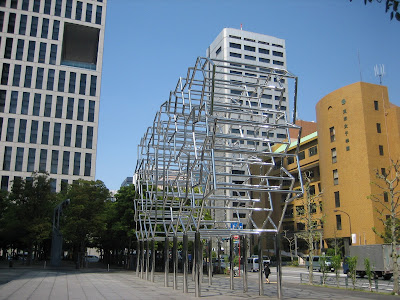On the school front of things, the main highlight was, as it usually is, the Anime and Video Games culture class. This week's class was another extra awesome edition because we had another guest speaker! This time was the producer of Shirogumi Inc.!
That might not be much of a bombshell at first hear, but they're actually a really major animation company for Japanese media - they've done a lot of animation and graphics work for lots of popular series and games. Some of their big stuff from recent years include the graphics of the Dark Souls and Armored Core series. They also did a lot of commercials for old Nintendo games such as Mario and Star Fox. The topic was about the job of being a producer for an animation studio. It wasn't as scintillating a topic as the last one, but still quite cool and informative. And we got to watch a lot of commercials and footage and sample stuff, so it was a fun class nonetheless. =D I'll bomb a few links just to give an idea of what kinda stuff they had.
(Shirogumi website) http://www.shirogumi.com/
(Mario Kart 64, JP CM) http://www.youtube.com/watch?v=134B-G7NFCA
(Mister Donut CM) http://www.youtube.com/watch?v=nf6YPHqQ3ig
(Pokemon XD, JP CM) http://www.youtube.com/watch?v=iU0QJsutUIk
The other adventure this week was a trip to Nakano over the weekend! We were going to the area's Mandrake, a chain of second-hand goods stores. The area itself was pretty sweet though, just walking out of the train station found me looking at a rather impressive view of the opening to a market street. It was all so picturesque, so I took a bunch of pictures as we walked along the street.
 |
| The shopping street right outside of Nakano station! It's actually outdoors'ish. Even if it looks like there's a roof with the window and all, you feel the outside air. |
 |
| Just a random shot. Look, a bakery! |
 |
| Revolving sushi restaurant. =w= I wish we went, now that I think about it, but too much shopping lol. |
 |
| Here's the big department store! Admittedly, I was really confused at the name Nakano Broadway, and was confused why were going in there for a while. |
 |
| Leonardo da Vinci gachapon. Did people really chunk 100¥s for this machine? It's funny at least though! |
 |
| Leaving. =( Night time in the ceiling window! |
So anyways, back to shopping. The Mandrake stores were actually only a few small outlets in a somewhat sizable department store, so we took the time to peek around the whole department store. There were quite a variety of places, actually - though most of them were merchandise stores of some kind. The local merchandise outlets were quite nice though, and had some really sweet rare finds of stuff from old series, so I was pretty happy about that (I found more Tales of Legendia things, pleasant surprise). Aside from the merchandise stores, there were also toy stores, jewelry and bag stores, a board game shop, a "weird stuff" store, and strangely enough, an army themed store. There were also mini-arcades strewn about running cabinets of older fighting games like Street Fighter II and Marvel vs Capcom 2. I'm no good at those old-school ones though, so I didn't play, though it was pretty interesting that these outlets were pretty populated.
Well, that's about the highlight events for the week. Nothing too extraordinary - school's school after all. Though, I feel like I could make some comments about what living in Japan has been like so far, now that it's been a few months.
If I had to describe living in Japan in short - I'd call it expensive, but very convenient and efficient. Everyday goods cost a little bit on the high side, usually around the price in the US or a little higher, but that's not too eye-widening of a problem. On the other hand, it's very interesting seeing the differences in Japan's take on the urban lifestyle compared to the US.
One of the foremost examples is the convenience store. I think I mentioned how awesome they were in one of my first blog posts, but I didn't realize then just how really convenient conbinis are here. To be honest, when I think about the convenience stores in the US, I usually think of it as a place to grab a quick snack with pals, or to get a sub sandwich for lunch.
In Japan though, it's really something that plays a vital role in people's lives. You can buy snacks and drinks of course, but there's a lot more than that. As mentioned before, there's bento sets which available which are similar in principle to TV dinners in the US, but a lot higher quality and probably more worth its cost. And healthier. And fresher. Also, you can get these bento sets microwaved at the register so they're ready to nom as soon as you get back home, if you so desire. It's quite a nice service really. They also sell general living supplies, such as toilet paper, paper kitchenware, garbage bags, shampoo & soap, toothpaste... pretty much anything daily life essentials, you can grab at your 5-10 minute nearby conbini.
Perhaps the most interesting service the conbini offers however, is bill payment. In Japan, it's very common for people to pay monthly bills through the conbini. Health insurance, rent, all those jazz - you can arrange to receive your bills for them in the mail with a barcode that can be scanned and paid at the conbini. As a foreigner, this is pretty great for me, since I don't have to set up a credit card or pay checks on a regular basis; just need to pay the bills at the conbini that I'm at almost every day anyways.
Speaking of convenience, Japan has a lot of convenient technology in place for so much of everyday life. For instance, I got something called a Suica card, which is basically this cash card that's used as an EZ-pass for public transportation such as buses and trains. I bought a daily commuter pass on it, which lets me ride the train to the campus where I have classes, or to any stop along that line - it's a money efficient deal just in going to school every day, but we can also sneak in savings by going to Mita and then transferring to get slightly lower ticket prices on trips that are nearer to Mita than Hiyoshi. Hooray! But more importantly, back to the convenience angle - these Suica cards are also usable in conbinis as a cash card, and you can actually scan them on most vending machines to pay for your drink. It's basically this card that you can use on any kind of daily life expense. Certainly not necessary, but Japanese society really likes to make use of everything they can.
A few other random things... oh, they have really useful implements for umbrellas lying around most public places. First of all, a lot of buildings that have visitors will have umbrella racks lying around, so that's a plus. Bringing those long umbrellas around indoors is always annoying. Second is, some places have this nice thing that wraps your umbrella into a plastic bag so it's not dripping around everywhere if you do bring it indoors. Thirdly, some places have a machine that's basically an automated umbrella dryer. You just dip your umbrella in, and swoosh it around, and it comes out all nice and dry. Makes using an umbrella a lot more appealing of an option around here!
Well, it's kinda late over here now, and I can't think of anything more off the top of my head, so I'll just leave it at that for now. Next time, I'll be sure to take memos when I do think of some interesting aspects in experiencing Japan, so maybe I'll have more to write here next week. Oh, and apparently we're having a field trip to the Shirogumi animation's studio for this coming week's anime and video game class. So that'll probably be a really cool thing to rant about. =3
'Til next time! As always, I hope you enjoyed the little read!





































